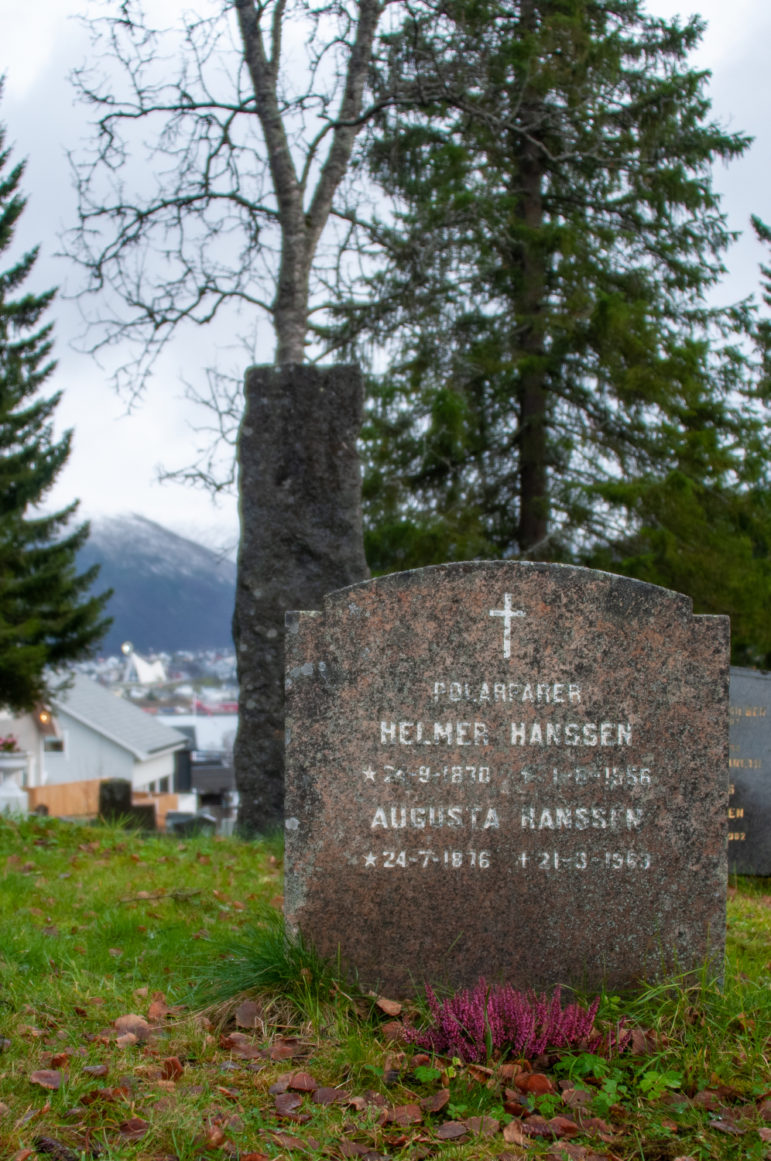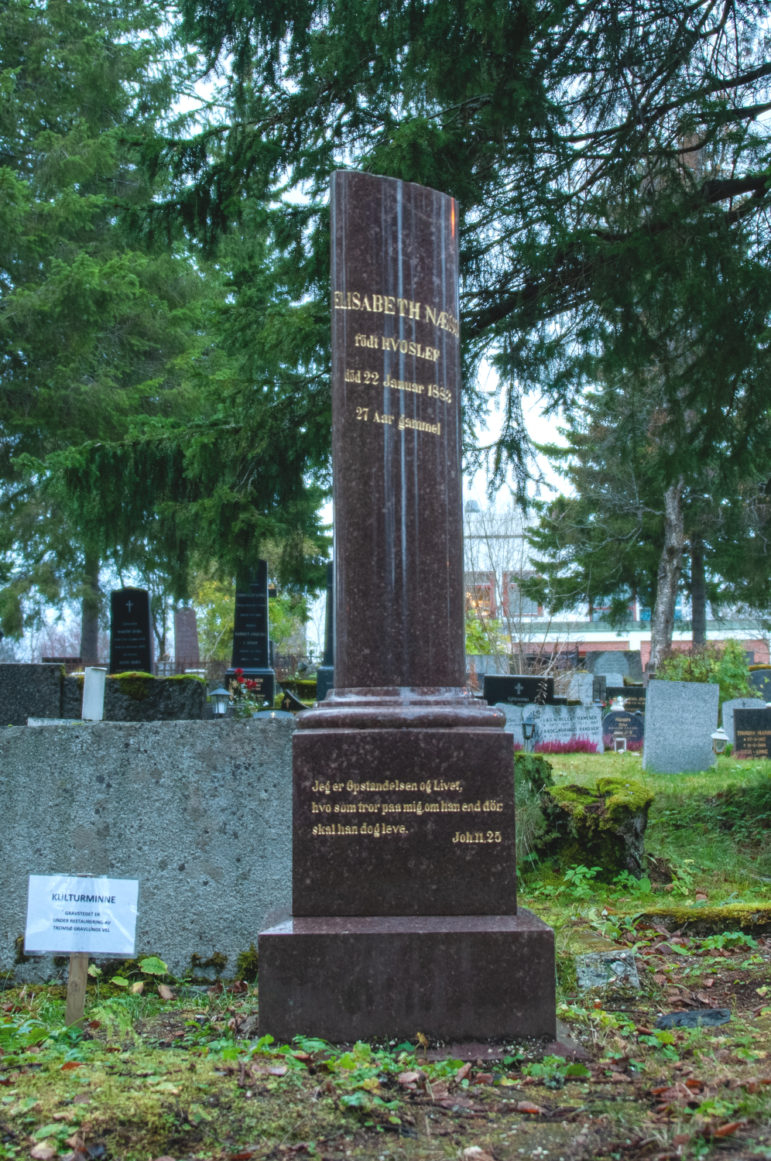
Fall has arrived in my hometown. Most of the trees have shed their leaves, leaving only a few lumps of bright red rowan-berries to color a landscape that is becoming grayer by the day. I, my wife, child, cat, and a friend have recently moved houses to the other side of town, and my semi-daily walks have become much longer as a result, especially my morning trip to the kindergarten. Until we can find something closer, we pretty much have no other option than keeping our one-year-old enrolled in her old kindergarten, which now sits 3.7 kilometers (2.2 miles) away from our new place. Even with our good old baby carriage (a massive, armored beast I dubbed “the panzer”) and (so far) an absence of snow on the ground, it is a brisk jog that takes me a good half hour one way. While the whole thing is rather tedious, there is a segment of this route I enjoy every time – the run through the graveyard.

Graveyard plaques for Johannes and Marie Hedevig Gievær, who passed in the 1830s [L. Perabo]
Up until the mid 19th century, the town’s only graveyard lay by the church, on the coast, but as the town grew larger and larger, it was decided to move it up by the hill, which lay outside the limits of the town proper by a small forested patch. (It was incorporated into the town in 1960.) Since then, tombstones, large and small, have been occupying the space, witness to the history and development of the city, up until our times.
There is something special about visiting graveyards that I believe many people feel, but cannot easily express. Graveyards are usually the most peaceful location one can find in any town, city, or village the world over. Graveyards are not ruled by daily routines and schedules: they are spaces in which time works in a different manner. Everything is stern, slow to change, seemingly undisturbed, and yet always in motion – a motion with ebbs and flows which mirror the opposite world, the world of the living, on the other side of its fence.
Back when I was a kid, I think I just sensed that, and it exerted a faint, yet omnipresent allure. As opposed to the outside world, the graveyard was a place without conflicts, fights, or other daily worries. In many ways, it was like stepping out of time and getting a look at a mirrored vision of reality. I remember the stout mausoleums, sporting slightly-decayed stony ornaments, the military quarter, and, most of all, the Freemason pillar.
Far in a corner, surrounded by other impressive, if less exotic tombs, the pillar literally stood out. Surrounded by a small chained-up fence, supported by four wide feet, and broken in the middle, the column looked like nothing else around. Coming closer to it, one could decipher discreet Freemason symbols, as well as an epitaph of sorts. While I might only remember the first few words of that text, I still picture them as clearly as if they stood in front of me, more than fifteen years back: Une colonne brisée pour une vie brisée, “a broken column for a broken life.” What kind of tragedy such an austere symbolism could hide?
As it happened, I never found out. I did not even really research much about it either, but, in my defense, I was but a child. Still, the encounter with the broken column marked me. It might very well have been the first time I got exposed to anything resembling occultism, and, more importantly, it made me see graveyards and other cemeteries as more that repositories for old bones. They were sources of knowledge, wisdom, and maybe even illumination of sorts.
I think about that a lot as I walk up and down the graveyard on my way to the daycare. I try to take different “lanes” so as to see graves I might have missed on previous forays, and see what little knowledge I can glean from these old stones. The largest monuments are the ones that stand out the most, naturally. Here on the left rests Zakariassen, the famous Arctic captain. Not far from him, it is Helmer Hanssen, who was Amundsen’s musher expert during the conquest of the South Pole. Down, next to a colorful residential street, stands the bust of Aldor Ingebrigtsen, the country boy who became a national politician.

The unassuming grave of the Polar Explorer Helmer Hanssen and his wife Augusta [L. Perabo]
It is almost as if just by the graves alone, one could write the history of the town. All the ishavskipper (“arctic sailors”) resting here are a good indicator of the importance of fur trading, and Polar shipping in the olden days. The war graves, both Soviet and British, as well as the couple individual stones engraved with the fateful date “1945,” are mementos of the Second World War. One can also see the evolution of the language on the more wordy stones, as well as the art styles of statues and reliefs, and even the religiosity of the departed and their loved ones through the imagery, and symbols displayed.
Smaller, less ornate graves often have something to say as well. Sometimes it is a small carving or gilding, like the cute poodles adorning the tomb of an old lady who died just a few years ago, or the characteristic helmet carved unto the tombstone of a departed fire chief. Something I have noticed, is how, from about the 1880s until the 1960s, it seemed to have been quite common to have one’s profession engraved unto a tombstone. Alongside a name, and maybe a place of birth or maiden name, these are often the only information carried by those graves, but I still find those most fascinating.
Here one could for example sight a mister Thyhdolt, a fiskekjøper (“fish-buyer”), herr Mortensen, a humble kaffebrenner (“coffee roaster”), or a certain Norberg, whose name is engraved within a relief of an artist’s palette. One I find particularly fascinating is a small grave sporting a bronze relief, a young navy mate named Harry Magnar Edmund Meyer, who died in Akron, Ohio, in 1964. Among women, such inscriptions are quite rare, and the most common epithet that appear is hustru (“housewife”), like with lady Dalsbø, who is depicted on a distinguished bronze relief alongside her husband the kompassmaker (“compass maker”). Still, there are some exceptions like miss Eide, who was proud enough of her life as a lærerinne (“teacher”) that she had it engraved with gilded letters unto her now well-weathered tombstone.

The grave of mate H.M.E. Meyer who died in Akron, Ohio in 1964 [L. Perabo]
The very names of the departed too, have their own stories. On the corner near the street, stands the high, Egyptian-inspired obelisks of the Ebeltoft family, a name that I met just a few days ago, on a poster for a concert featuring one likely relative of theirs. Here I can see a Wilhelmsen, maybe a relative to Gunnar, of the same name, the town’s current mayor? Over there I see another grave, mister Aune, probably the erstwhile owner of the famous Aunegården villa in the city-center? It is hard to make more than a few steps without seeing names that sound familiar: names that are alive and well today, proudly carried on by artists, business-folks, journalists, authors, and other notables. Is it surprising that, walking among the dead, I think so much about the living?
There is no denying it: Going through the graves and making the acquaintances with the dead, if only for a few seconds, can feel sometimes almost exhilarating. In a way, it is kind of like reading a good old history book, if the book was a little forested slope and its pages were made of standing stones. I am obviously not the only one who feels that way, considering that graveyard tours are regularly arranged by local historians and theatre-folks. There is also the local charity which takes care of the upkeep of the graves, as well as the small chapel, a little wooded marvel built in Norse and Medieval-inspired Dragon style more than a century ago.
I remember also well how, before Covid, I used to walk myself through the graveyard with my tourists, showing them the chapel and the graves, and how they often reported feeling cozy, and even at times enchanted by that short trek slightly off the beaten track. There is undeniably a connection that exists between us who dwell on earth, and those who dwell under. I think this is why, for many people, graveyards, cemeteries, and other mausoleums don’t feel particularly threatening. At the end of the day, there is so much the living can learn from the dead, that even if they remind us of our own mortality, it is still worth connecting with them.
Far from merely being monuments to separation, suffering and sorrow, as they are all too often portrayed in media, the many graves that adorn the surface of the earth should better be understood as bindings, small chains connecting the worlds. Symbolically embedded in the deep soil, and rising skyward, they are what link past and future, thought and memory. They serve as reminders to the ancestors, and that one day, all of us will join them. The graves simultaneously keep us grounded in our daily lives, but also make us consider what came before, and what will come after us, they bring peace, wisdom, and sometimes even wonder in their eternal wake.

The broken pillar tombstone of Elisabeth Næss. [L. Perabo]
As I thought this article finished, I headed to the graveyard to take a few pictures on site to help illustrate it. Even as I originally only planned on walking down the main path in the middle of the yard, I could not help but step out, and wander off, mesmerized by old stones I had not yet inspected. After hopping from bronze reliefs to weathered crosses, my eye caught sight of a red sandstone sculpture in the distance, as I came closer to it, I smiled. It had all come full circle. I had found another broken column, this time commemorating the life of Elisabeth Næss, a young lady who died almost a hundred years ago. Here there was, yet another mystery, a question mark, a riddle. I might not know who you are, miss Næss who now rest among the earth, but meeting you in the cemetery made my day, and for that, I salute you.
THE WILD HUNT ALWAYS WELCOMES GUEST SUBMISSIONS. PLEASE SEND PITCHES TO ERIC@WILDHUNT.ORG.
THE VIEWS AND OPINIONS EXPRESSED BY OUR DIVERSE PANEL OF COLUMNISTS AND GUEST WRITERS REPRESENT THE MANY DIVERGING PERSPECTIVES HELD WITHIN THE GLOBAL PAGAN, HEATHEN AND POLYTHEIST COMMUNITIES, BUT DO NOT NECESSARILY REFLECT THE VIEWS OF THE WILD HUNT INC. OR ITS MANAGEMENT.
The Wild Hunt is not responsible for links to external content.
To join a conversation on this post:
Visit our The Wild Hunt subreddit! Point your favorite browser to https://www.reddit.com/r/The_Wild_Hunt_News/, then click “JOIN”. Make sure to click the bell, too, to be notified of new articles posted to our subreddit.
